Table of Contents
Hint: It’s not up, down, or packed
Most exercise form posts and videos focus everywhere EXCEPT the neck.
Yet neck position profoundly influences what the rest of your body will do.
So where should your neck be while you lift? Like on a deadlift, squat, or press?
I’m answering that for you today.
If you want to protect ya neck as the Wutang said, then you definitely have to check this out.
Read the post, watch the video, and listen to the podcast to learn all about it!
How neck position influences the rest of the spine during movement
Neck position influences a WHOLE LOT MORE than your neck.
In fact, where you place your neck can influence the ENTIRE spine.
I’m not making this up either! Look at the anatomy fam. Look at how far down some of the neck muscles run:




- Splenius capitis and cervicis – Run all the way down to the spinous processes of T3 and T6 respectively (photo credit – Mikael Häggström and Uwe Gille)
- Trapezius – Runs all the way down to T12 (photo credit – Wikimedia Commons)
- Erector spinae – Run as far down as the iliac crest of the pelvis (photo credit – Henry Gray)
And that’s just muscle. Most of the neurodynamic literature also illustrates the interconnectivity along the spine.
The point is that the anatomy clearly shows how distant spinal areas are not so distant. The spine in a sense acts as a whip. You “snap” one area and eventually, the other end of the whip will “snap.”
Want to feel this whip? Run this quick experiment:
- Sit with your normal posture, bring your chin to your chest
- Sit with a big arch in your back, bring your chin to your chest
- Sit with your weight on your ischial tuberosities (butt bone), bring your chin to your chest
Did you notice a difference with each position? Typically, it’ll be easier to touch your chin to your chest with your weight on your ischial tuberosities, and more difficult when you arch your back…all while doing NOTHING to your neck (or did you?).
If neck position influences the rest of the spine, it’s probably a good idea to care about where our head is while we lift some big ole’ weights. But how do we determine the “best” neck posture while lifting?
The three keys for determining optimal neck position during lifting
When lifting weights, we want to maintain a neck position that promotes:
- Ideal intrathoracic and intra-abdominal pressure for weightlifting
- Enough spinal motion to complete the lift and not overload any specific regions.
- An open airway (think the position you keep the head at when giving CPR)
If we focus purely on sagittal plane lifts (think squat, deadlift, split squat, bench, pressing, etc), we really have four options at our disposal:
- Looking up
- Looking down
- Packing the neck
- “Neutral”
My bias is number four, but let’s look at the pros and cons of each of these positions individually.
Looking up
When looking up, the lower back arch increases, which places more loads on the posterior structures (e.g. the facet joints).

While this position will somewhat keep the airway open, the deep arch pushes the abdominal contents forward. This action increases the difficulty to create an abdominal brace needed to move weight.
Moreover, the increased spinal extension will significantly reduce any rotational range of motion in the spine. You’d think this would be a good thing, but stealing too much rotation will at best limit the depth, at worst overload the posterior spinal structures.
In my mind, looking up the entire time = FAIL.
Looking down
As you can imagine, looking down has the opposite problem of looking up. Now, the spine over flexes, and can potentially put too much focal load on the spinal disks and anterior structures.
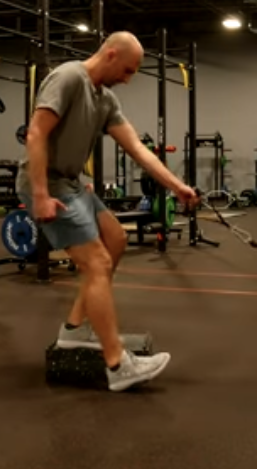
When flexing the neck, the thorax tilts anteriorly, which pushes the abdominal contents significantly downward, much like we see when someone has a pooch belly. As you can imagine, this position negatively impacts our ability to create intrathoracic and intraabdominal pressure.
What’s more, your airway is not really going to be all that open here, as the upper cervical flexion will reduce airway dimensions.
Lastly, the one pro is that spinal flexion will allow for A TON of movement to be available, but in some folks, it may be overkill in terms of the amount needed to complete the lifts in question.
It’s safe to say that looking down = SUS.
Packing the neck
Ah packing the neck (aka cervical retraction). This action produces an even workload between frontside and backside structures, but it comes at some major costs.
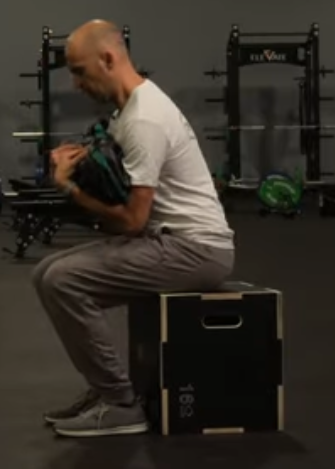
First off, packing the neck closes off the airway in a major way. This closure will limit how much air we can pull in our bodies, so we sacrifice the ability to create adequate intrathoracic and intraabdominal pressure.
What makes packing the neck a potentially useful strategy is that it limits rotation in the spine, but given the poor pressurization capabilities, we probably have too much motion loss to consider this strategy useful.
Therefore, because you can’t really breathe well here, and you kinda sorta need to be able to breathe, we don’t take kindly to packin’ necks around these parts.
Neutral neck
The sweet spot is somewhere in the middle. I hate saying neutral because we really can’t measure a center point, so let me unpack how I’m defining this position:
Neutral = slight upper cervical (OA joint) extension + slight lower cervical flexion
It looks like this:
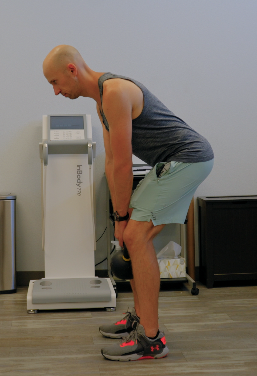
Here’s why I think this is the best damn neck position you can have when you lift:
- It keeps the airway open, which allows you to build up your intrathoracic and intrabdominal pressure
- It keeps the load between all the spinal structures more evenly distributed
- It allows an appropriate amount of motion to have enough range to complete the lift, but not more than is needed
You can see why this neck position is vastly superior to the other options.
But how do we coach our supreme clientele to attain this posture?
I’M GLAD YOU ASKED!
Coaching neck position during lifts
So far, we’ve learned that the neck influences the entire spine, and neck position closely influences our pressurization skills.
What if pressurization and lower spine position is whack at the start? Chances are, you won’t be able to get a good neck position from the get-go. We want to address that first.
Neck position starts with lower ribcage position.
If the ribcage is too far forward (aka rib flare), then you’ll end up looking too far up. If you have a slouched posture with A TON of rectus abdominis (6-pack) muscle activity, you’ll look too far down. If you overbrace, well poop, you won’t be able to MOVE.
We want some middle ground here fam! Here is that middle ground:
- Exhale slowly, softly, and as full as comfortable
- Lower abs (below the belly button) should get smaller (don’t draw in though)
- Lower ribcage should get smaller (don’t force it down though)
If you need practice, you can try this drill here:
Now we have our starting point. With this position, we want to inhale while keeping the little bit of abdominal tension we acquired from the exhale.
NOW, it’s time to protect ya neck!
Here’s how I coach neck position:
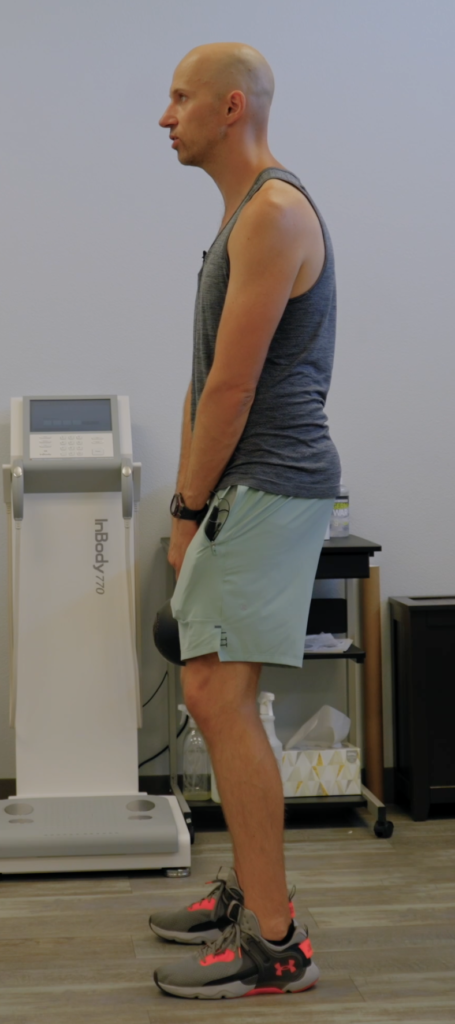
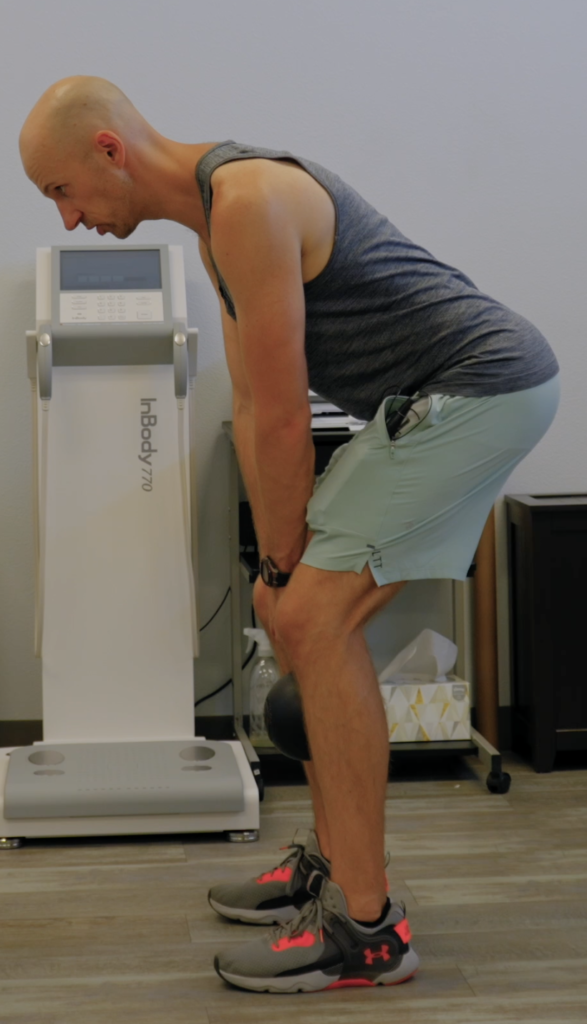
- Slightly untuck your chin from your neck
- Look at the horizon at the start
- Eyes look about 10 feet away as you lower the weight
Focusing on each of these cues will solve pretty much all the faulty neck issues we mentioned previously.
- Looking up too much? Gaze 10 feet away as you lower
- Looking too down? Untuck your chin and look 10 feet away (most look 3-5 feet away)
- Packing the neck? Untuck that chin yo!
Sum up
If you hit these cues, you ought to keep your spine in a good position while you lift, move some big weights, and actually feel the areas working that you should feel.
To summarize:
- Neck position influences the ENTIRE spinal orientation while you lift
- Neutral neck posture gives us the best amount of airway space, intrathoracic and intraabdominal pressure, and allows for adequate motion
- Get lower ribcage position first by a soft, slow, and full exhale
- Keep chin untucked, horizon look at the start, 10 feet away as you lower
What struggles have you had with neck positioning? Comment below and let the fam know!
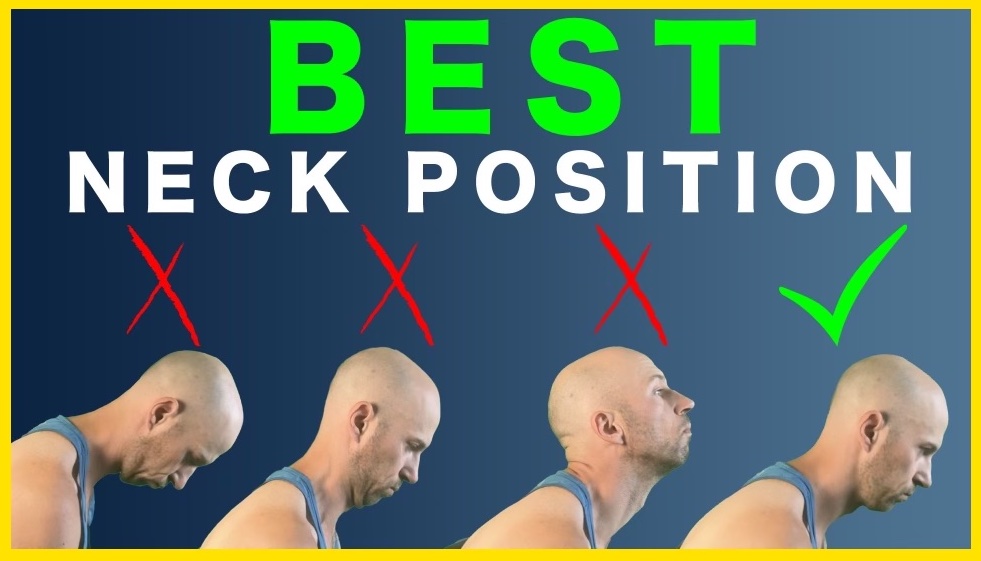
great stuff zac. having had a c5-c6 fusion many years ago ive wondered what would best benefit my neck with training
It’s hard to say without seeing where you are at currently, where you want to go, and if you have any medical restrictions. Many possibilities!